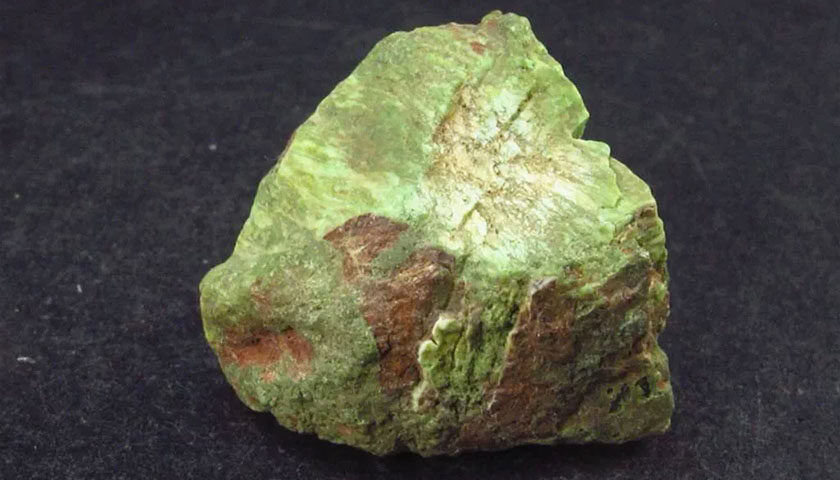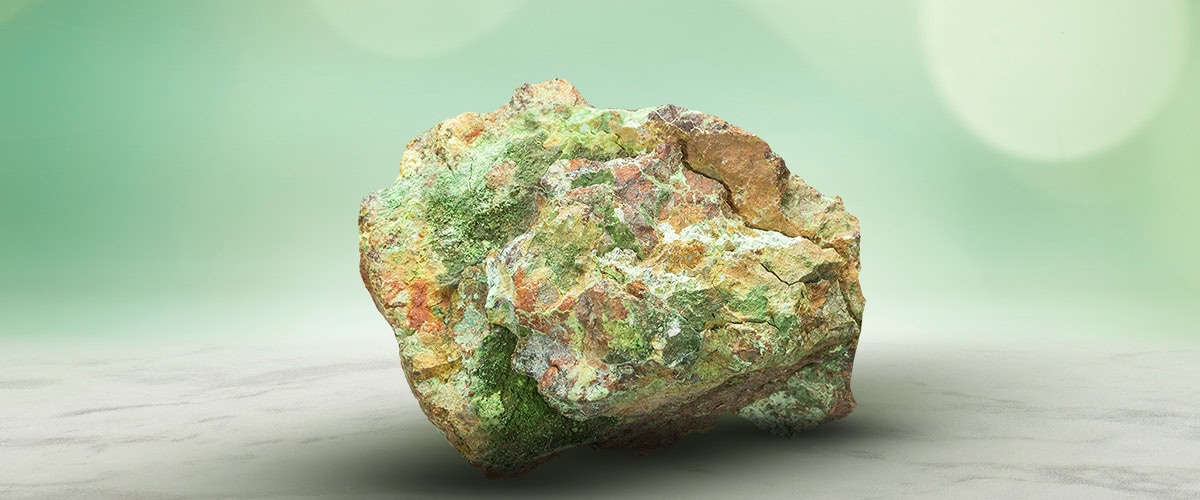Article Highlights
Imagine stumbling upon a hidden treasure, a gem so rare and vibrant that it seems to capture the very essence of nature’s beauty. That’s gaspeite for you! Discovered on the picturesque Gaspe Peninsula of Quebec, Canada, this gem didn’t make a splash in the scientific world until 1966. But don’t let its relatively short history fool you; gaspeite is a gem that’s rapidly carving out its place in the world of fine jewelry and spiritual healing.
Gaspeite’s claim to fame lies in its dazzling green hues, reminiscent of the first tender leaves of spring. As a member of the calcite mineral group, it’s not just another pretty face; it’s got the pedigree to match. But what’s truly exciting is how this gem has danced its way into the limelight over the past couple of decades. It’s become the darling of Southwestern-style jewelry, adding a pop of verdant color that’s hard to miss. Imagine the striking contrast of gaspeite set against turquoise, coral, or lapis lazuli, all nestled in sterling silver — it’s a sight to behold!
The Physical and Chemical Realm
Physical Properties of Gaspeite
Dive into the world of gaspeite, and you’ll find yourself mesmerized by its yellowish-green to bright green shades. It’s like holding a piece of the forest in your hands, with colors so vivid they seem to pulse with life. The stone’s luster ranges from dull to vitreous, adding a mysterious allure that beckons you closer. And with a Mohs hardness of 4.5 to 5.0, it’s got a gentle strength, like a whispering breeze that’s somehow powerful enough to bend the trees.
Composition of Gaspeite
At its heart, gaspeite is a nickel carbonate, but it’s got a few tricks up its sleeve. It often plays host to magnesium and iron, which sneak in to substitute for nickel in a solid solution. This means that the stone you gaze upon isn’t just a simple mineral; it’s a complex symphony of elements, each adding its note to the melody of colors and properties. When magnesite joins the party, the resulting stone can range from a subtle lemon to a vibrant green. But don’t get fooled by market names like “lemon chrysoprase”; gaspeite is in a league of its own.
Gaspeite’s Geologic Ballet
Gaspeite doesn’t just appear out of thin air; it’s the result of a cosmic dance between the earth’s forces. Picture it as a secondary mineral, emerging from the transformation of rocks rich in nickel. This gem is a child of the earth, born from the weathering of ultramafic igneous rocks or the alchemy of hydrothermal metamorphism. It’s a globe-trotter too, with siblings found in the rugged landscapes of Western Australia and the remote reaches of Quebec, Canada. Each piece of gaspeite carries with it a tale of the earth’s past, a story of transformation and beauty.
Identifying Gaspeite
Identification Techniques
Spotting gaspeite is like recognizing an old friend in a crowd. Its signature yellowish-green to bright green color is your first clue. But there’s more to this gem than meets the eye. Give it a gentle test with dilute hydrochloric acid, and watch for the subtle effervescence, a secret signal between you and the stone. For the more technically inclined, a refractometer can reveal the gem’s inner world, with a refractive index that speaks of its unique identity.
Gaspeite Meaning & History

Gaspeite’s Spiritual Significance
Dive into the world of gaspeite, and you’ll find more than just a stone; you’ll find a spiritual companion. Across cultures, especially among indigenous Australian tribes, gaspeite is revered as a talisman of protection, a guide for spiritual journeys, and a beacon for those seeking to connect with the earth’s wisdom. It’s said to be a lucky charm that can facilitate vision quests and out-of-body experiences, offering a bridge between the physical and spiritual worlds.
Gaspeite’s Journey Through Time
But where did gaspeite come from? Picture the rugged landscapes of the Gaspe Peninsula in Quebec, where in 1966, this gem first whispered its name to the world. Since then, it’s traveled far and wide, finding its way into Southwestern jewelry in the 1970s and capturing hearts at gem shows in the ’90s. Today, gaspeite stands as a testament to the earth’s creativity, a gemstone with a story as rich and vibrant as its color.
Gaspeite Gemological Literature
Gaspeite’s Academic Journey
Gaspeite might not be the most chatted-about gem in academic circles, but when it does make an appearance, it’s always a headline act. Picture this: It’s 1994, and the Gem and Mineral Show in Tucson is buzzing. Among the glittering array of stones, green cabochons labeled “Allura” catch the eye. But wait, they’re not what they seem. They’re gaspeite, and this revelation sets the gemological world abuzz. It’s moments like these, documented in publications like Gems and Gemology, that mark gaspeite’s exciting cameo appearances in the academic spotlight.
Misunderstandings and Clarifications
Then there’s the tale of the “lemon chrysoprase.” Marketed under this sunny name, these stones turned out to be magnesite with a twist — a dash of nickel giving them that distinctive green hue. It’s likely gaspeite playing a cheeky game of hide and seek within the magnesite. These gemological plot twists are not just fascinating tales but also crucial insights for enthusiasts and professionals alike, ensuring that the true identity and value of gaspeite are recognized and appreciated.
Gaspeite Aesthetics
The Allure of Gaspeite’s Colors
Let’s talk about what makes gaspeite such a showstopper — its color palette. From the subtlest yellow-greens to the richest olive shades, gaspeite is a symphony of greens. Each stone is like a canvas, with nature painting its masterpiece in hues that echo the heart of the earth. And those brown veins and mottlings? They’re not flaws; they’re signatures, each one telling a unique story of the stone’s journey from deep within the earth to the palm of your hand.
Carving, Cutting, and Caring
Gaspeite’s soft, inviting surface is perfect for cabochons, beads, and the most intricate carvings. Imagine the hands of a skilled artisan, gently coaxing out the stone’s inner beauty, transforming it into a piece of jewelry that’s not just an accessory but a piece of art. But remember, with beauty comes responsibility. Gaspeite, with its delicate nature, needs a little extra care. A soft cloth, a gentle touch, and a safe place to rest will keep your gaspeite looking as lovely as the day it was crafted.
Gaspeite Formation and Sources
The Birth of Gaspeite
Gaspeite’s story begins long before it sparkles on a display. It starts in the quiet, dark places of the earth, where nickel-rich rocks undergo transformations that would baffle the imagination. Weathering and hydrothermal forces work their magic, and voilà, gaspeite is born. This stone is a testament to the earth’s power to create beauty from the mundane, to transform the ordinary into the extraordinary.
Gaspeite Healing Properties
Physical and Emotional Healing
Gaspeite isn’t just another pretty stone; it’s a healer, a guardian, a friend. While it’s a newcomer to the healing stone scene, those in the know whisper about its potential to soothe the heart and lungs, to ease stress, and even to assist in the journey of weight loss. It’s like having a personal cheerleader, encouraging you to take care of yourself, body and soul.
Emotional Courage and Protection
But gaspeite’s real power lies in its ability to delve into the emotional realm. Imagine a stone that offers a protective embrace while gently nudging you to confront your deepest wounds. Gaspeite is that friend who holds your hand as you journey into the past, providing the courage to heal and the strength to move forward.
Gaspeite vs. Green Turquoise
Now, let’s clear up a little confusion. Gaspeite and green turquoise often get mistaken for each other, but they’re like distant cousins with their own unique charms. Gaspeite is a touch softer than turquoise, with a density that tells of its solid, earthy origins. And the colors! Gaspeite dances in shades of yellow and green, while turquoise steps out in blues and greens.
Gaspeite Care and Cleaning
Loving Your Gaspeite
Gaspeite isn’t just a stone; it’s a companion, and like all companions, it needs a bit of TLC. Think of it as a delicate flower, beautiful but vulnerable. Avoid harsh chemicals and bumps, and when it’s time for a clean, a gentle wipe with a soft cloth will do the trick. And when you’re not wearing your gaspeite, give it a special place to rest, away from the hustle and bustle. It’s not just about preserving its beauty; it’s about honoring the journey it’s taken to reach you.



